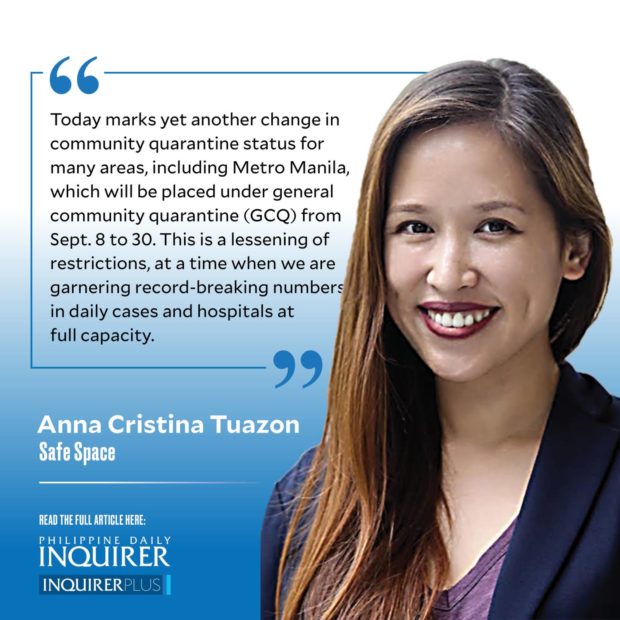Confusing classifications do not help
GCQ. GCQ with heightened restrictions. GCQ with granular lockdown. MECQ, but-hey-still-no-dine-in-or-religious-gatherings-allowed-so-it’s-really-ECQ. Confused yet?
Today marks yet another change in community quarantine status for many areas, including Metro Manila, which will be placed under general community quarantine (GCQ) from Sept. 8 to 30. This is a lessening of restrictions, at a time when we are garnering record-breaking numbers in daily cases and hospitals at full capacity. What makes things even more uncertain is what this current iteration of GCQ will look like. They have announced that, this time, they will pilot a four-level granular lockdown (oddly enough, without telling us what the four levels are, as of this writing).
A year and a half into the pandemic, citizens should already instantly know what to expect and how to prepare when a GCQ, MECQ, or ECQ is announced. But we don’t — because they keep changing the rules. This causes panic behaviors, such as hoarding and mass exodus, because we don’t know what we’ll have access to. This also prevents businesses to adapt smoothly because they don’t know what will be allowed. A global pandemic is chaos enough; we do not need confusing classifications that increase unnecessary uncertainty and panic.
Ideally, classifications are designed to help organize events and conditions so that people can understand and respond to the situation more quickly. Think about the storm signal system used by Pagasa, where people knew which signal number would mean cancellation of schools or require immediate evacuation. Think about medical triage of red, yellow, and green and how quickly first responders can prioritize a patient tagged as red. Good classification systems help communicate important information effectively to communities without the need for much explanation, allowing them to respond effectively.
Good classifications tend to have ordinality. We know that signal number 3 is worse than signal number 2. We know that red is more urgent than green. The reason we ask patients to rate their symptoms and experiences on a scale of 1 to 10, for example, is to get a comparative context of the intensity of their suffering. Depending on their identified number on the scale, we can gauge the appropriate treatment and intervention, which brings me to my next point: good classifications should be useful.
It is not enough to know what quarantine name we are in; it is more important that we know what to do. When is it time to pause in-person operations? Is it safe to go out and buy groceries? Am I allowed to take a walk around the block? If “GCQ” means something different every single time, with guidelines released right before implementation, this does not allow me to take immediate and appropriate action to keep my family and household safe.
Good classifications should be relatively stable and consistent. Redefining your classification levels with every activation increases uncertainty, fosters a lack of faith and trust in government, and makes things downright confusing for people. Uncertainty, unpredictability, and lack of control are a recipe for disastrous mental health and wellbeing for people in a prolonged crisis. This breeds hopelessness and cynicism, leading to inaction or recklessness. When the rules are confusing and ever-changing, people learn to disregard them altogether.
The criteria and conditions for changing classification status should be clear and transparent. A year and a half into the pandemic, we should already have identified important indicators that would require community quarantine. If people understand the reasons why we must activate a quarantine, they are more likely to comply. Factors such as hitting a critical number of active cases, mortality rate, density or magnitude of case clusters, and hospital capacity are not likely to be questioned by the community.
People are willing to put up with inconveniences if they are assured that doing so will prevent more quarantines in the future. When asking the public to sacrifice, we must assure them that solutions—and not just band-aids—are being applied. Ramping up vaccinations will decrease severity and fatality, requiring much fewer health resources. Aggressive contact tracing and testing prevent spread, leading to less need for city or region-wide lockdowns. Less lockdowns mean less damage to the economy. Make it make sense and people will follow.





















